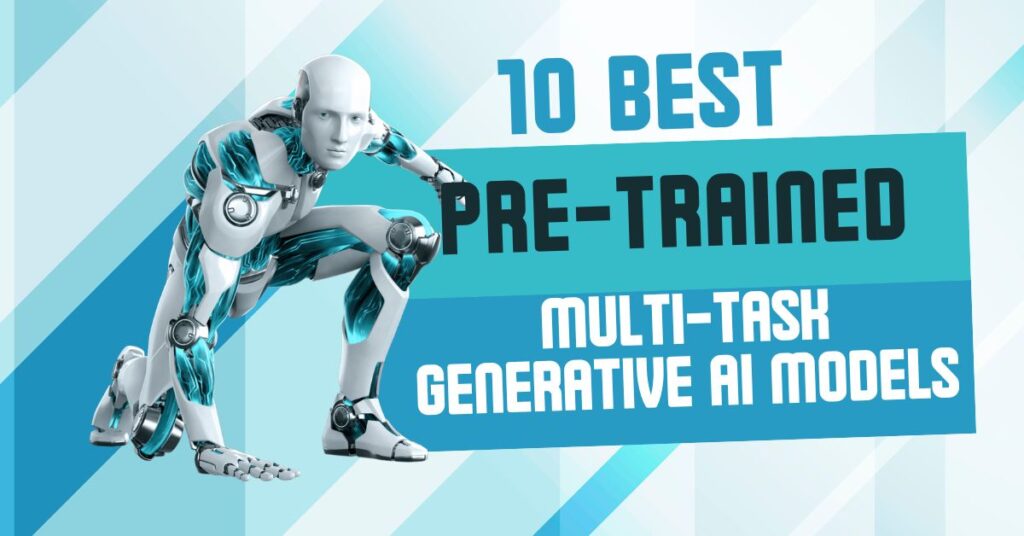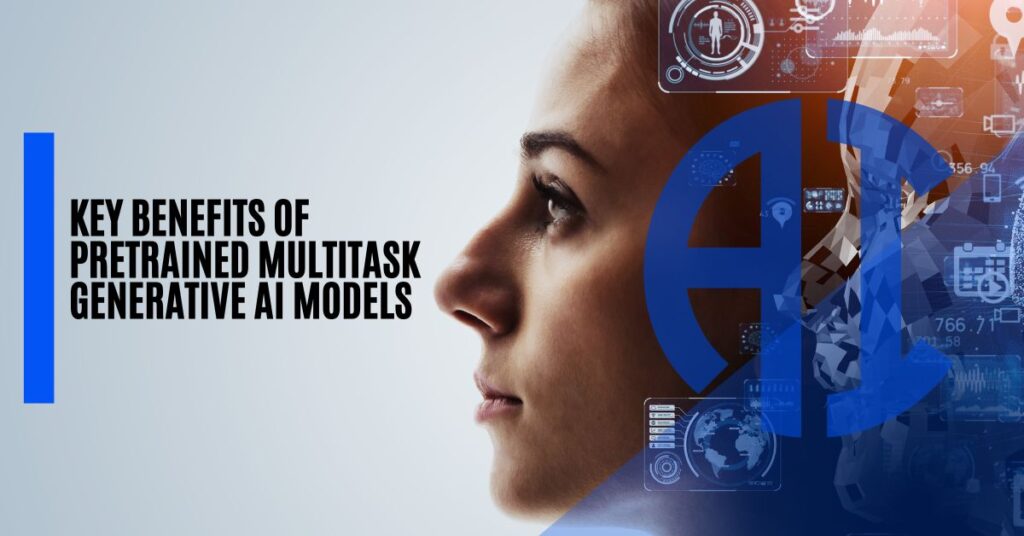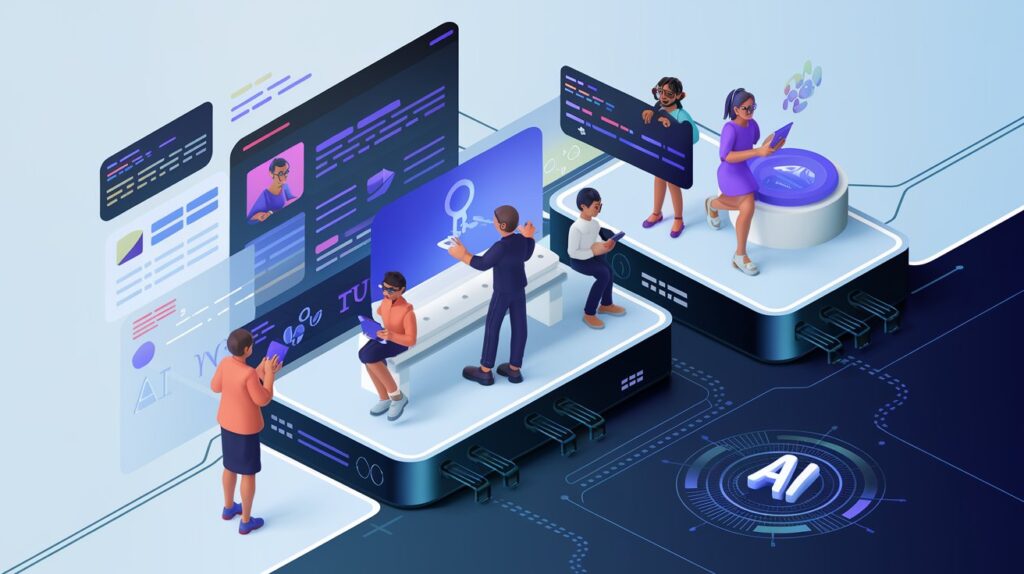Generative AI is transforming industries, but pre-trained multi-task models represent an even greater leap forward. These powerful systems aren’t limited to single tasks but can handle multiple tasks across domains, making them a critical innovation in artificial intelligence. Whether you’re a business leader, developer, or AI enthusiast, understanding these models is crucial to harnessing their full potential. In this article, we’ll explore what pre-trained multi-task generative AI models are, why they matter, and how they’re used. We’ll break down complex concepts into actionable insights, recommend tools, answer frequently asked questions, and offer practical tips to help you navigate this evolving field.
Table of Contents
Introduction: Why Pre-Trained Multi-Task AI Models Matter
Imagine a machine that can perform multiple tasks with high precision—creating text, generating images, solving math problems, and even coding—using a single AI model. This is the promise of pre-trained multi-task generative AI models. A striking statistic: AI usage in businesses has grown by 270% over the past four years, according to Gartner, largely due to advancements in multi-task models. These systems cut costs, save time, and accelerate productivity across industries. In this article, we’ll explain:
- What pre-trained multi-task generative AI models are
- Their applications across industries
- Leading tools in this domain
- How businesses can implement these models
- Key benefits, challenges, and best practices
By the end, you’ll have a comprehensive understanding of how multi-task generative AI can revolutionize your business or project.
What Are Pre-Trained Multi-Task Generative AI Models?
A pre-trained multi-task generative AI model is a type of artificial intelligence that is trained on vast datasets and designed to handle more than one task. Unlike traditional AI models that specialize in a single function (like image recognition or language translation), these models can generate content across multiple tasks or domains. The “pre-trained” aspect means they come with pre-existing knowledge, so they require minimal additional training for task-specific applications.
How They Work
These models leverage vast neural networks and massive amounts of data to learn generalized patterns. For example, OpenAI’s GPT-4 and Google’s PaLM are pre-trained multi-task models capable of generating human-like text, answering complex questions, and even writing code. The core of these models often lies in transformer architecture, which allows for high-level understanding and generation across various tasks.
Applications of Pre-Trained Multi-Task Generative AI Models
1. Content Creation
Pre-trained models like GPT-4 are widely used for automating content creation, including blog writing, email drafting, and product descriptions. Multi-task models also enable the creation of visual content, allowing businesses to automate entire creative workflows.
Example: Marketing agencies use these models to generate ad copy, design banners, and create social media content—saving both time and resources.
2. Software Development
Multi-task AI models can generate code, suggest improvements, and even debug errors across various programming languages. This automation is a game-changer for developers looking to expedite the software development lifecycle.
Example: GitHub Copilot, powered by OpenAI, assists developers by suggesting code snippets, reducing the time spent on repetitive coding tasks.
3. Healthcare
AI models can read medical images, generate patient reports, and predict treatment outcomes. Multi-task models, in particular, enable cross-functionality by handling tasks like language processing and image recognition within one system.
Example: Radiologists use AI to analyze X-rays and CT scans, while also leveraging the model to generate comprehensive diagnostic reports.
4. Customer Support
Generative models can manage customer inquiries, automate ticket resolution, and generate reports from data analysis, making them an invaluable asset in support centers.
Example: Chatbots powered by AI models not only answer customer queries but also generate insight reports for human agents.
Pre-Trained Multi-Task Generative AI Tools

1. GPT-4
Overview: GPT-4, developed by OpenAI, is one of the most advanced language models available. It’s designed for tasks such as natural language understanding and generation, translation, summarization, and even code generation. With its ability to process massive amounts of data and produce human-like text, GPT-4 is a versatile tool used across industries.
Key Features:
- Natural language generation and understanding.
- Multilingual capabilities.
- Code generation for various programming languages.
- Context-aware responses in chatbots or virtual assistants.
Use Cases: Content creation, software development, customer support, and automation for businesses in need of text generation and language processing.
Pricing: Free tier available with limited access, $20/month for the pro version with priority access.
2. Google PaLM
Overview: Google’s Pathways Language Model (PaLM) is a powerful generative AI designed for multi-domain and multilingual tasks. It has the capability to handle a wide range of functions like translation, text generation, and coding while learning from fewer examples than traditional models.
Key Features:
- Handles more than 100 languages.
- Powerful multi-task functionality, including text, code, and reasoning capabilities.
- Improved efficiency in training and inference, making it faster than many competitors.
Use Cases: PaLM is ideal for businesses needing multi-lingual support, healthcare applications, and high-level reasoning across tasks.
Pricing: Custom pricing based on specific business needs.
3. IBM Watson
Overview: IBM Watson is a comprehensive AI platform that provides powerful AI-driven solutions across multiple industries, including healthcare, customer support, and business automation. Watson’s AI models are pre-trained on a variety of data sources, making it adaptable for multi-task operations.
Key Features:
- Language processing and decision-making.
- Customizable pre-trained AI models for specific industries.
- Tools for automating business workflows and decision-making processes.
Use Cases: IBM Watson is widely used in enterprise settings for automating customer service, analyzing data, and improving decision-making processes in industries like healthcare and finance.
Pricing: Custom pricing depending on the size and needs of the business.
4. DeepMind AlphaFold
Overview: AlphaFold by DeepMind is an AI model specifically designed for predicting protein folding, but its multi-task abilities make it applicable to a wide range of scientific tasks. This model has revolutionized biological research by predicting protein structures with high accuracy, offering huge benefits in healthcare and drug discovery.
Key Features:
- Accurate protein structure prediction.
- Open-source access for scientific and academic communities.
- Can be applied to drug discovery and various healthcare applications.
Use Cases: Widely used in scientific research, particularly in biology and healthcare, to predict how proteins fold and interact, leading to faster drug discoveries.
Pricing: Free to use, especially for academic and research purposes.
5. Hugging Face Transformers
Overview: Hugging Face is an open-source platform known for its extensive library of pre-trained models, particularly in natural language processing (NLP) tasks. Hugging Face’s models, built on transformer architecture, can perform a variety of tasks like text generation, translation, and question-answering.
Key Features:
- Huge repository of pre-trained models.
- Support for NLP, computer vision, and multi-modal tasks.
- Open-source and developer-friendly with APIs for easy integration.
Use Cases: Hugging Face is popular among developers, researchers, and businesses for tasks like chatbot creation, language translation, and document summarization.
Pricing: Free with paid tiers for enterprise-level support and features.
6. Claude by Anthropic
Overview: Claude is an AI assistant developed by Anthropic, built on the principles of safe and reliable AI. It focuses on providing human-like conversations and decision-making capabilities. Claude is designed for a wide variety of applications, from customer support to content generation.
Key Features:
- Safe, human-like conversational AI.
- Decision-making assistance across various domains.
- Strong focus on AI safety and reliability, reducing biases.
Use Cases: Claude is useful for businesses looking to enhance customer interactions, content generation, and decision-making processes with ethical AI practices.
Pricing: Custom pricing based on usage and business needs.
7. Meta’s LLaMA
Overview: LLaMA (Large Language Model Meta AI) is Meta’s advanced AI language model. It’s designed to be highly efficient in terms of computational power while maintaining the ability to handle multiple tasks across domains such as content creation, knowledge answering, and translation.
Key Features:
- High efficiency in terms of computational resources.
- Capable of performing multiple text-based tasks, including content generation and question-answering.
- Open access for researchers and developers.
Use Cases: Suitable for content creators, researchers, and companies needing efficient multi-task AI without the need for high computational resources.
Pricing: Free and open access for researchers, with options for enterprise use.
8. Cohere’s Command R
Overview: Cohere’s Command R is designed for fast, real-time language generation and understanding. Its API allows businesses and developers to integrate natural language understanding into their workflows. Command R excels in text classification, summarization, and language understanding.
Key Features:
- High-speed, real-time text generation and classification.
- Multi-lingual language understanding.
- Easy integration via APIs for developers.
Use Cases: Cohere is best for businesses needing fast and efficient NLP solutions for customer support, content creation, and data analysis.
Pricing: Custom pricing based on business and developer needs.
9. Microsoft Azure OpenAI
Overview: Microsoft Azure’s OpenAI Service offers GPT-based models for business applications, allowing companies to integrate powerful AI into their workflows. It includes capabilities like text generation, language understanding, and decision-making.
Key Features:
- Pre-trained models with API access for easy integration.
- Scalable solutions designed for enterprise-level applications.
- GPT-based models for text generation, language understanding, and more.
Use Cases: Ideal for enterprise businesses looking to integrate AI into various functions like customer support, software development, and decision-making processes.
Pricing: Custom pricing based on the scale and usage of the models.
10. Anthropic AI Assistant
Overview: Anthropic’s AI assistant offers robust human-like interaction capabilities, focused on ethical and safe AI implementation. The assistant is designed to help with multi-tasking in areas such as customer support, productivity, and decision-making.
Key Features:
- Safe and reliable conversational AI.
- Capable of managing multi-task decision-making processes.
- Strong focus on ethical AI, minimizing biases and ensuring fairness.
Use Cases: Best for customer interaction, productivity enhancement, and businesses needing AI assistance across different tasks while ensuring ethical practices.
Pricing: Custom pricing based on usage and business needs.
Comparison Table of Leading Pre-Trained Multi-Task Generative AI Tools
Here’s a quick look at some of the leading pre-trained multi-task AI tools, their features, and pricing models.
| Tool | Key Features | Use Cases | Pricing |
|---|---|---|---|
| GPT-4 | Natural language generation, code completion | Content, software dev | $20/mo (Pro) |
| Google PaLM | Multilingual, multi-domain tasks | Healthcare, translation | Custom pricing |
| IBM Watson | AI-driven automation, language understanding | Customer support, analytics | Custom pricing |
| DeepMind AlphaFold | Protein folding predictions, scientific tasks | Healthcare, research | Free |
| Hugging Face Transformers | Open-source multi-task models | Research, education | Free/Paid |
| Claude by Anthropic | AI assistant, natural language generation | Customer support, content automation | Custom pricing |
| Meta’s LLaMA | Multi-task text generation, knowledge answering | Content creation, research | Open access |
| Cohere’s Command R | Fast text generation, language understanding | Marketing, research | Custom pricing |
| Microsoft Azure OpenAI | GPT-based models for business applications | Enterprise AI, software dev | Custom pricing |
| Anthropic AI Assistant | Human-like conversation, decision-making tasks | Customer interaction, productivity | Custom pricing |
Each tool offers a unique set of strengths, and the choice depends on your specific needs—whether it’s for business, development, or research.
Key Benefits of Pre-Trained Multi-Task Generative AI Models


1. Versatility
One of the greatest advantages of pre-trained multi-task models is their versatility. These systems can handle tasks in various domains—natural language processing, image generation, coding, etc.—without needing to train different models for each task.
2. Cost and Time Efficiency
Instead of building and training multiple models, organizations can use a single, pre-trained multi-task model for multiple functions, saving both computational resources and human effort.
3. Accelerated Innovation
With the ability to handle complex, multi-domain tasks, these models enable faster prototyping and innovation in areas like software development, healthcare, and scientific research.
Challenges in Implementing Pre-Trained Multi-Task Models
1. Computational Costs
While pre-trained models save time on training, their size and complexity often demand significant computational resources, especially during deployment. Smaller organizations may struggle with the infrastructure requirements.
2. Ethical Concerns
Multi-task models are trained on diverse datasets, which may include biased or harmful content. Ensuring ethical AI deployment is a significant challenge, requiring strategies to mitigate bias and ensure fairness in outcomes.
3. Data Privacy
Using pre-trained models for sensitive tasks, especially in healthcare or finance, raises concerns about data privacy. Ensuring that models comply with regulations like GDPR is essential.
FAQs About Pre-Trained Multi-Task Generative AI Models
What is a multi-task generative AI model?
A multi-task generative AI model can perform more than one task, such as text generation, image creation, or code writing, using a single AI architecture.
How do these models differ from traditional AI models?
Traditional AI models are task-specific, while multi-task models are designed to handle multiple tasks, offering greater versatility and cost-efficiency.
Are multi-task models better than single-task models?
It depends on the application. For broad, diverse tasks, multi-task models excel, but for highly specialized tasks, single-task models may still perform better.
How can I integrate a pre-trained multi-task model into my business?
You can integrate pre-trained models through APIs provided by companies like OpenAI, Google, and Hugging Face. Understanding your specific needs will guide which model is best suited for your business.
Practical Tips for Implementing Pre-Trained Multi-Task AI Models
- Start with Pre-Trained Models: Instead of training models from scratch, use pre-trained versions like GPT-4 or Google PaLM to reduce computational costs.
- Use Open-Source Tools: For businesses or developers with limited budgets, leveraging open-source platforms like Hugging Face can be an economical way to get started.
- Focus on Specific Use Cases: While multi-task models are versatile, it’s important to identify specific business needs they can address—such as content automation or customer service improvement.
- Monitor Ethical Usage: Ensure that your AI models are compliant with ethical standards and avoid reinforcing biases in decision-making processes.
Tool Recommendations
Here are some of the best tools for leveraging pre-trained multi-task generative AI models:
- OpenAI’s GPT-4: Perfect for content creation, software development, and customer support.
- Google’s PaLM: Ideal for businesses requiring multilingual and multi-domain task performance.
- Hugging Face Transformers: Great for developers and researchers, offering open-source pre-trained models for a wide array of tasks.
- GitHub Copilot: Streamlines code generation and improves software development workflows.
Conclusion
Pre-trained multi-task generative AI models represent a paradigm shift in artificial intelligence. By automating tasks across domains, they offer incredible versatility, efficiency, and innovation opportunities. While challenges like computational costs and ethical concerns remain, the benefits far outweigh the limitations. As AI continues to evolve, businesses and developers who adopt these advanced models will be at the forefront of technological progress.


